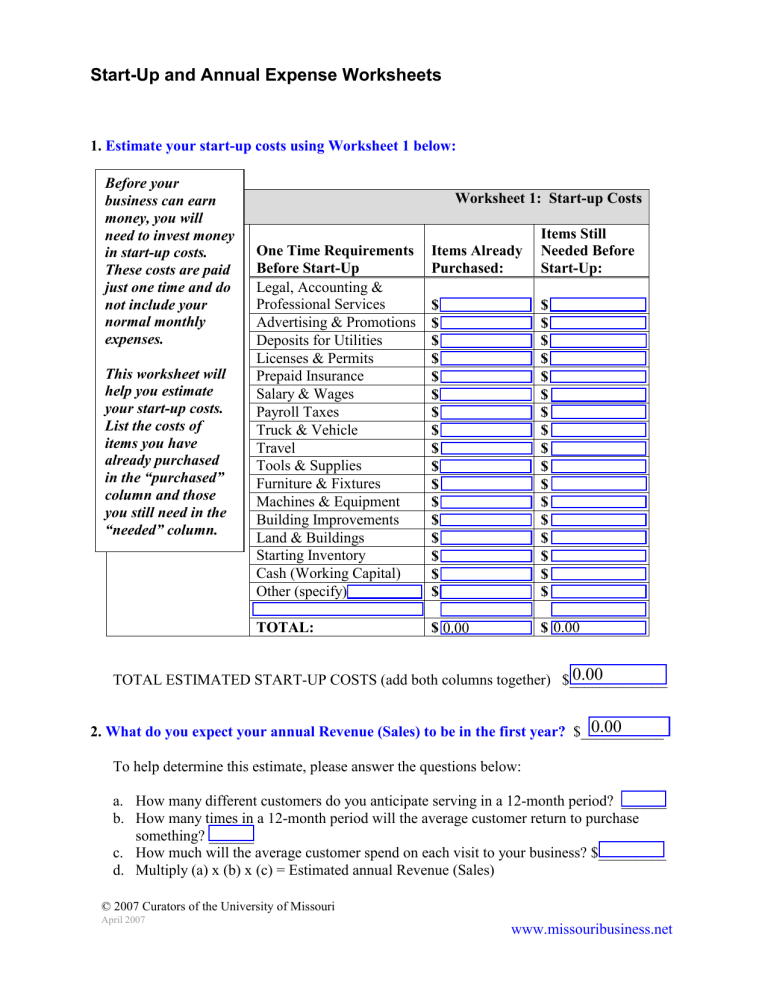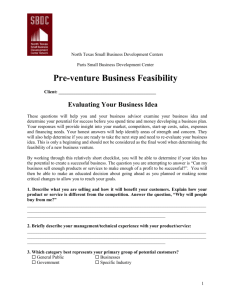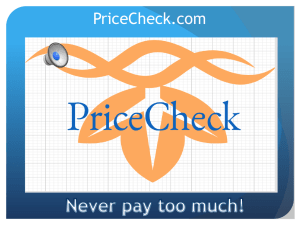Start-Up and Annual Expense Worksheets

Start-Up and Annual Expense Worksheets
1. Estimate your start-up costs using Worksheet 1 below:
Before your business can earn money, you will
Worksheet 1: Start-up Costs need to invest money in start-up costs.
These costs are paid just one time and do not include your
One Time Requirements
Before Start-Up
Legal, Accounting &
Professional Services
Items Already
Purchased:
$
Items Still
Needed Before
Start-Up:
$ normal monthly expenses.
Advertising & Promotions
Deposits for Utilities
Licenses & Permits
$ $
$ $
$ $
Prepaid Insurance $ $ This worksheet will help you estimate your start-up costs.
List the costs of items you have already purchased in the “purchased”
Salary & Wages
Payroll Taxes
Truck & Vehicle $ $
Travel $ $
Tools & Supplies
Furniture & Fixtures
$ $
$ $
$ $
$ $ column and those you still need in the
“needed” column.
Machines & Equipment
Building Improvements
$ $
$ $
Land & Buildings $ $
Starting Inventory $ $
Cash (Working Capital) $ $
Other (specify) $ $
0.00
2. What do you expect your annual Revenue (Sales) to be in the first year?
0.00
To help determine this estimate, please answer the questions below: a. How many different customers do you anticipate serving in a 12-month period? ______ b. How many times in a 12-month period will the average customer return to purchase something? ______ c. How much will the average customer spend on each visit to your business? $_________ d. Multiply (a) x (b) x (c) = Estimated annual Revenue (Sales)
© 2007 Curators of the University of Missouri
April 2007
www.missouribusiness.net
3. Estimate your annual sales and earnings using Worksheet 2 below:
Forecasting “Sales and Earnings” is important for your financial success. It may take several years before your business begins to generate
“satisfactory” profits but your sales goal should be to breakeven (match sales with expenses) by the end of the first year and show modest profits for Years 2 and 3 . Do not include start-up costs on this worksheet.
Worksheet 2: Sales and Earnings
*1 st
Year 2 nd
Year 3 rd
Year
Total Revenue (Sales): $ $ $
Less: Cost of Goods Sold $ $ $
Gross Profit: 0.00
0.00
Less Expenses:
Salaries & Wages $ $ $
Outside Services $
Office Supplies & Postage $
Dues & Subscriptions $
Donations $
Rent $
Telephone $
Utilities $
Loan Payments $
Interest $
Depreciation $
$
$
$
$
$
$
$
$
$
$
Advertising & Promotions $
Truck & Vehicle $
Travel $
Payroll Taxes $
Taxes, Licenses & Permits $
Legal & Accounting Services $
Insurance $
Repairs & Maintenance $
$
$
$
$
$
$
$
$
$
$
$
$
Bad Debts $ $ $
Miscellaneous (unspecified) $ $ $
Other Expenses: $ $ $
$
$
$
$
$
$
$
$
$
$
$
$
$
$
$ $ $
$ $ $
$ $ $
0.00
0.00
Total Expenses: 0.00
NET PROFIT 0.00
0.00
2
NOTE : For best results in using these worksheets, please answer each question to the best of your ability. When you have completed it, you are encouraged to seek the professional assistance of the Missouri Small Business Development Center staff in your area. Professionals can help you interpret your results and provide you with resources to further explore and develop your business idea. To find the office nearest you, visit our website at http://www.missouribusiness.net/sbdc/centers.asp
or call toll-free 1-888-751-2863.
Reset Form
Notes:
www.missouribusiness.net
3
1. Estimate your start-up costs using Worksheet 1 below:
Before your business can earn
Worksheet 1: Start-up Costs money, you will need to invest money
Items Still in start-up costs.
These costs are paid
One Time Requirements
Before Start-Up
Items Already
Purchased:
Needed Before
Start-Up: just one time and do not include your normal monthly expenses.
Legal, Accounting &
Professional Services
Advertising & Promotions
Deposits for Utilities
$ $
$ $
$ $
This worksheet will help you estimate your start-up costs.
List the costs of items you have already purchased in the “purchased” column and those you still need in the
“needed” column.
Licenses & Permits
Prepaid Insurance
Salary & Wages
Payroll Taxes
Truck & Vehicle
Travel
Tools & Supplies
Furniture & Fixtures
$ $
$ $
$ $
$ $
$ $
$ $
$ $
$ $
Machines & Equipment
Building Improvements
Land & Buildings
Starting Inventory
$ $
$ $
$ $
$ $
Cash (Working Capital) $ $
Other (specify) $ $
TOTAL ESTIMATED START-UP COSTS (add both columns together) $______________
Estimating your start-up costs is critical to getting started. These are one-time costs incurred prior to beginning your business operations. These costs will help you determine how much money is needed to launch and maintain your business until you generate enough sales to cover normal operating expenses.
Legal, Accounting & Professional Services – professional fees associated with registering your legal form of business, reviewing contracts and agreements and preparing financial information for your business plan. Also includes consultants and other professionals.
Advertising & Promotions – includes all promotional costs associated with “opening” your business.
Deposits for Utilities – advance payments required to obtain electric, gas, telephone, water and sewer.
4
Licenses & Permits - fees for licenses, permits and other requirements related to starting your business and making its operations legal.
Prepaid Insurance – advance payments required to obtain business insurance that protects the contents of your business against fire, theft and other losses.
Salary & Wages – payroll to owner and employees for training and business setup “prior to opening” the business.
Payroll Taxes – usually 10-15% of gross payroll costs.
Truck & Vehicle – includes mileage, parking, tolls, etc. “prior to opening” the business.
Travel – include conference, hotel, meal and transportation charges for securing prospective distributors, suppliers, and customers.
Tools & Supplies – services, supplies and tools purchased for use in the business. ("Prior to opening")
Furniture & Fixtures – acquisition cost plus installation expense. If you plan to pay by installments, enter your down payment.
Machines & Equipment - acquisition cost plus installation expense. If you plan to pay by installments, enter your down payment.
Building Improvements – include costs of structural changes, repairs, HVAC upgrades, painting and decorating.
Land & Buildings – include the down payment for lease, rent or purchase and deposits required.
Starting Inventory – include acquisition cost plus transportation.
Cash (Working Capital) – amount of money you will need to maintain your business until you generate enough sales to cover normal operating expenses.
Other (specify) – include those start-up costs that may be unique to your business and do not have an account listed on the worksheet.
5
2. What do you expect your annual Revenue (Sales) to be in the first year?
$___________
To help determine this estimate, please answer the questions below: a. How many different customers do you anticipate serving in a 12-month period? _______ b. How many times in a 12-month period will the average customer return to purchase something? ______ c. How much will the average customer spend on each visit to your business? $__________ d. Multiply (a) x (b) x (c) = Estimated annual Revenue (Sales)
Estimating your annual Revenue (Sales) will help you set a sales goal for your business and provide you with tools to manage your day-to-day operations. The Revenue (Sales) estimate is based on three factors: 1) the number of different customers you anticipate serving; 2) the number of times the average customer will return to purchase something; and 3) the average expenditure each customer will make per visit. By monitoring each of these factors on a daily, weekly and monthly basis, you will know if your business is on target to meet its sales goal or if adjustments must be made to increase sales or decrease expenses.
6
3. Estimate your annual sales and earnings using Worksheet 2 below:
Forecasting “Sales and Earnings” is important for your financial success. It may take several years before your business begins to generate
“satisfactory” profits but your sales goal should be to breakeven (match sales with expenses) by the end of the first year and show modest profits for Years 2 and 3 . Do not include start-up costs on this worksheet.
Worksheet 2: Sales and Earnings
*1 st
Year 2 nd
Year 3 rd
Year
Total Revenue (Sales): $ $ $
Less: Cost of Goods Sold $ $ $
Gross Profit:
Less Expenses:
$ $ $
Salaries & Wages $
Outside Services $
$
$
$
$
Office Supplies & Postage $
Dues & Subscriptions $
Donations $
Rent $
Telephone $
Utilities $
Loan Payments $
$
$
$
$
$
$
$
$
$
$
$
$
$
$
Interest $
Depreciation $
Advertising & Promotions $
Truck & Vehicle $
Travel $
Payroll Taxes $
Taxes, Licenses & Permits $
$
$
$
$
$
$
$
$
$
$
$
$
$
$
Legal & Accounting Services $
Insurance $
Repairs & Maintenance $
Bad Debts $
Miscellaneous (unspecified) $
Other Expenses (specify each) $
$
$
$
$
$
$
$
$
$
$
$
$
$
$
$
$
$
$
Total Expenses: $ $ $
NET PROFIT $ $ $
*NOTE: 1st Year data required to answer questions 13 and 14.
7
Revenue (Sales) - use the formula provided in Question 11 to estimate annual revenue for each year.
Cost of Goods Sold – estimate the cost of sales for the sales found under Revenue (Sales).
Include labor used to produce the product or service (direct labor), materials used in the final product or service (direct material), and their transportation and handling costs.
Gross Profit – Total Revenue (Sales) minus Total Cost of Goods Sold equals Gross Profit
Salaries & Wages – Base pay plus overtime and bonuses, include owner’s draw on this line item. (NOTE: For purposes of estimating net profit, it is important that all costs, including owner’s draw, be part of the projection).
Outside Services – includes cost of sub-contracts, overflow work farmed out, special or onetime purchase of services.
Office Supplies and Postage – services and items purchased for use in the business and not for resale.
Dues and Subscriptions – include subscriptions to professional, technical, and trade journals that deal with your business field. Also include membership fees.
Donations – gifts to charitable or non-profit organizations.
Rent – include only real estate used in the business. List equipment and other rentals under
“Other Expenses.”
Telephone – include all line charges associated with fax, Internet and telephone.
Utilities – water, sewer, gas, electric, etc.
Loan Repayments – include interest and principal that must be paid to lender. (NOTE: For purposes of estimating net profit, it is important that all costs, including principal paid, be part of the projection).
Depreciation – If property you acquire to use in your business has a useful life of more than one year, you generally cannot deduct the entire cost as a business expense in the year you acquire it. You must spread the cost over more than one tax year and deduct part of it each year.
Advertising & Promotions – includes all the costs associated with making your products and services known to your customers.
Truck & Vehicle – includes mileage, parking, tolls, etc.
Travel – business trips; include conference, hotel, meal and transportation charges.
8
Payroll Taxes – includes paid vacations, sick leave, health insurance, unemployment insurance, Medicare and social security taxes. (Note: Usually 10-15 % of gross payroll).
Taxes, Licenses & Permits- excise tax, inventory tax, real estate tax, sales tax, other nonpayroll taxes and license or permit fees as applicable.
Legal & Accounting Services– include cost of outside professional services.
Insurance – includes Commercial General Liability, Property, Commercial Auto,
Workmen’s’ Compensation, umbrella policies and Bonding. (Note: Does not include Health
Insurance).
Repairs & Maintenance – regular maintenance and repair, includes painting and decorating.
Bad Debts - A business bad debt is a loss from the worthlessness of a debt that was created or acquired in your trade or business, or is closely related to your trade or business when it became partly or totally worthless. A debt becomes worthless when there is no longer any chance that the amount owed will be paid.
Miscellaneous (unspecified) - Small expenditures without separate accounts.
Other Expenses – tools and equipment that are “expensed” (not set up on a depreciation schedule); and payments for leased or rented equipment.
9


